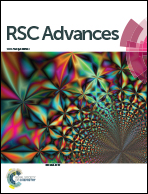Understanding the electron density reorganization upon stacking vs. H-bonding interaction in methyl gallate–caffeine complexes
Abstract
The crystal structure of methyl gallate–caffeine complex combines H-bonding and π–π stacking interactions, becoming a model case to get insight into the joint effect of these intermolecular interactions on electronic reorganization. Selected subcomplexes contained in this crystal structure were subjected to analysis by using the Quantum Theory of Atoms in Molecules, QTAIM. This analysis in complexes formed through stacking reveals that a small amount of electron density is transferred from methyl gallate to caffeine. The reverse charge transference (CT), to a larger extent, takes place in in-plane H-bonding complexes. In-plane CTs dominate in complexes showing both kinds of interactions. Cooperative effects are nearly negligible when caffeine is surrounded by methyl gallate molecules, while they become significant in complexes where methyl gallate is placed in the central position. This different behavior can be explained considering the H-bonds established between caffeine units in the latter complexes. QTAIM analysis also indicates that stacking interactions are characterized by a depletion of the electron density in the intermonomer region and a modification of their atomic quadrupole moments.


 Please wait while we load your content...
Please wait while we load your content...